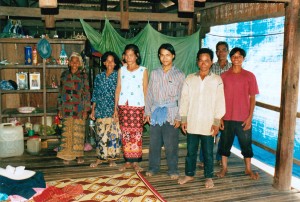[In January 2003 I accompanied an expedition that was conducting a survey of river dolphins on a stretch of the Mekong River in Cambodia. The expedition was led by Isabel Beasley, who was then a PhD student specializing on Orcaella brevirostris: also known as the ‘Irrawaddy Dolphin’ this species is found in many Asian river systems and deltas. The journal I kept during the expedition will appear on this site as a continuous series of posts. This is part 21 of the series.]
Earlier in the day we stopped at another small place – just a single hut surrounded by breadfruit and cassava plants – and found a forty-ish man sitting there. Isabel went up to the man’s hut and asked, through Mr Somany, if he had seen any dolphins in the area.
No, the man said, he hadn’t seen any, but then he hadn’t been there very long. It was just a short while, he explained, since he had left the Khmer Rouge. For a long time he had been a soldier in the Khmer Rouge army and had only recently got out. We bought some cucumbers from him.
After lunch I told Isabel that I’d like to go on to the place where we were going to spend the night as I’d like to get on with my notes. She seemed relieved to hear this – maybe she’s had enough of my trailing her about – and suggested I leave straight away. This is what I decided to do. We went on for some 15 minutes or so and arrived at a small settlement on the banks of the Mekong, a slightly more prosperous village than the last, which seemed very dilapidated indeed. Mr Bann led me to the hut where we were to stay – a long-house built on stilts. As I write now, I am surrounded by members of the family who are whispering to each other as they look at this notebook over my shoulder, ‘Anglais’, ‘Anglais’.



Wonderful reading these posts. Just curious if this was the basis for Piyali Roy in “The Hungry Tide”.
Enjoyed meeting you in Bangalore, and looking forward to the third edition of the Ibis Trilogy, the only book written by you I haven’t read.